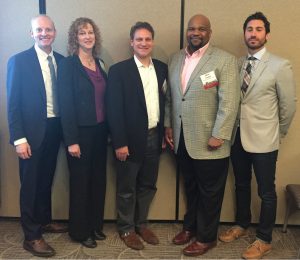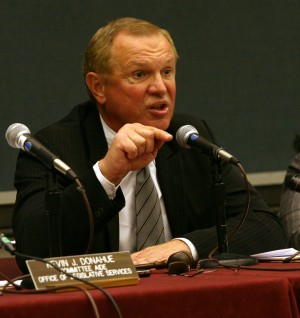New Jersey Future Blog
Forum Roundup: The Triple-Bottom-Line Beauty of Green Infrastructure
April 19th, 2016 by Kandyce Perry

L to R, panelists Russ Dudley, Tetra Tech; Michele Adams, Meliora Design; Eric Rothman, HR&A Advisors, Inc.; Christopher Franklin, Brandywine Realty Trust; Matthew Testa, Bijou Propoerties
With a room filled to capacity, the Triple-Bottom-Line Beauty of Green Infrastructure panel session at Redevelopment Forum 2016 provided a refreshing response to the looming realities of climate change heard in the opening plenary session. Why? Because green infrastructure can help mitigate some impacts of climate change.
The goal of green infrastructure (GI) is to manage stormwater by enabling it to infiltrate into the ground where it falls or by capturing it for later reuse. This approach improves environmental quality by reducing or preventing runoff, sequestering carbon dioxide, reducing heat island effect, filtering contaminants to improve water quality, and recharging groundwater.
“We can’t have trees everywhere, but we can engineer like trees,” observed Michele Adams, president of Meliora Design, as she spoke during the panel session. She pointed out that trees are powerful sponges, soaking up huge quantities of stormwater.
In addition to effective stormwater management benefits, green infrastructure provides economic and societal benefits, rounding out its triple-bottom-line beauty.
There is a misconception associated with green infrastructure: that it costs more money compared to conventional piped drainage systems. In terms of life cycle costs, however, GI often comes out ahead, according to panelists. Their observations are supported by studies conducted by NRDC and EPA, as well as developers at the leading edge of the practice and even multinational companies like Unilever, Swiss Re, Dow and Shell, who attest to capital and operating expense savings, labor reduction and operational performance. In public-sector projects, green infrastructure can make the difference in areas that experience nuisance flooding, helping towns and property owners avoid the high cost of expanding or replacing old pipes. Green infrastructure often increases property values by creating more safe and beautiful places for people to live and work.
Basic market forces also support green infrastructure. Panelists Matthew Testa, director of construction for Bijou Properties, and Christopher Franklin, director of construction for Brandywine Realty Trust, both noted that their firms are building with green infrastructure because their customers are asking for it. “The triple bottom line doesn’t mean you have to make a third less money,” said Testa.
And then there’s the impulse to go one step further. The team at Brandywine recognized a market opportunity in their Cira Green green roof at the Cira Centre South building in Center City Philadelphia. The roof already manages 2 inches of rainfall—more than Philadelphia’s requirement to capture a minimum of 1.5 inches. But beyond that, the team at Brandywine realized they could also provide a desirable space for students living next door, professionals working in the nearby office buildings, and the community at large to study, relax, eat lunch, and enjoy the outdoors.
“We didn’t have to do it, but it was the right thing to do … We wanted to go above and beyond and not just create a flat green surface. We wanted [the green roof] to be more transformative and take advantage of the city skyline,” said Franklin.
Across the river, New Jersey Future has been engaging with green infrastructure design professionals and developers through its Mainstreaming Green Infrastructure program to make green infrastructure the first choice for stormwater management in New Jersey.
















